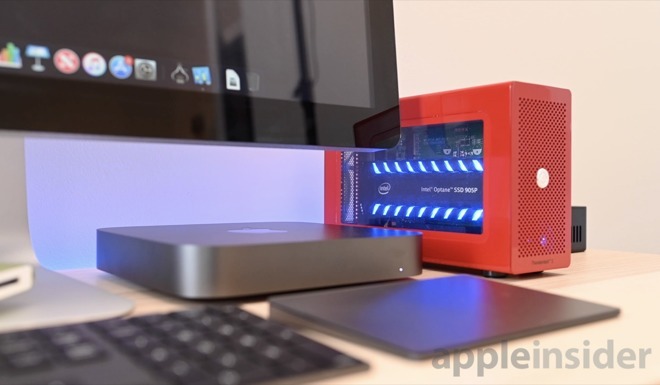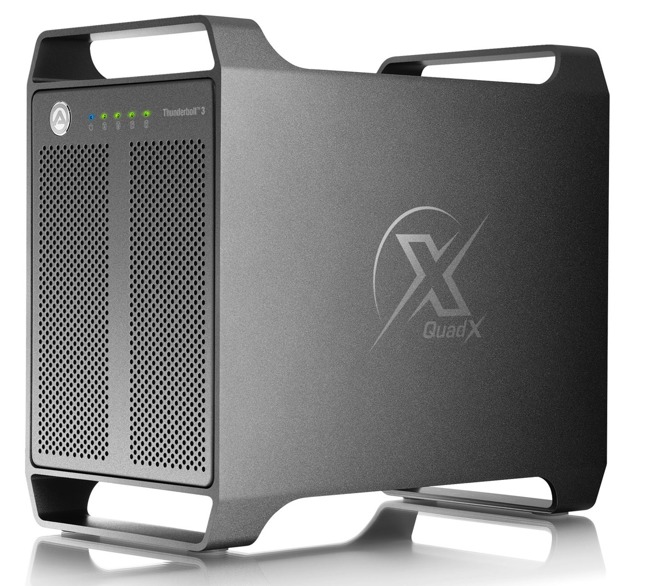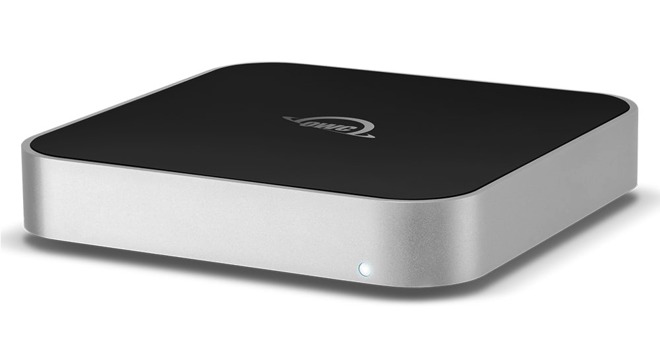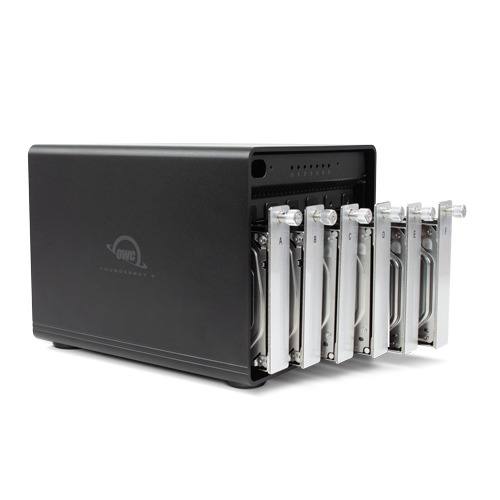Here are the best external drive enclosures for your new MacBook Air or Mac mini
Whether or not Apple's flash storage pricing on the new MacBook Air and Mac mini is worth it, is an exercise for the reader. But, given the high-speed Thunderbolt 3 interface on both of the new machines, as well as on the MacBook Pro and iMac, there are a variety of avenues to choose from to add storage to a Mac, quickly - and we have some that we've used and can recommend.

2018 Mac mini with Thunderbolt 3 Akitio Node Lite
In an ideal world, you'd like multi-gigabyte per second speed, in massive amounts of terabytes, and you want it cheap. The three are incompatible, though, so it's probably best to prioritize what's most important to you. And, unless you have an unlimited budget, with all priorities, assembling your own storage array is probably your best, and cheapest, choice.
As a note, we're not looking at single-drive enclosures that deeply, and we've already picked some good network attached storage devices. For the most part, this article will cover advanced home users, small businesses, the "Prosumer" market, and the "Pro" workflow not including large groups needing simultaneously-accessible mass storage. SAN units and enterprise multi-homing network attached storage are topics for another day.
We're aware that there are literally thousands, if not tens of thousands, of options. But, this isn't just a random list -- we've used all of these, and recommend them to our readers.
Buying from an Apple authorized reseller can also offer additional perks. Adorama, for instance, will not collect sales tax on orders shipped outside New York and New Jersey, potentially saving many shoppers up to $210 on MacBook Air models with up to 1.5 terabytes of storage. No interest financing offers are available for up to 12 months as well.
But, there is another option. If you want to use the Thunderbolt 3 bus about as fast as it can go, there's the Node Lite Thunderbolt 3 drive from Akitio that fits the bill -- but at a cost.
Akitio is bundling the Intel Optane 905P 960GB PCIe SSD that can handle 2.6 Gigabytes per second read speed, and 2.2 Gigabytes per second write speed, with it's PCI-E enclosure that as an added bonus has a DisplayPort 1.2 for an external monitor.
Be prepared to pay for it, though. The drive with 960GB of storage retails for $1499.
If you want to "roll your own", the OWC Thunderbay 6 will take six 3.5-inch hard drives. Using OWC's SoftRaid or to a lesser extent, Apple's Disk Utility, users can line up those drives any way they want, for maximum speed or maximum data protection.
The Thunderbay 6 retails for $679 without drives, with a fully-populated configurations ranging to $2699 with 48TB of storage.

Akitio Thunder 3 Quad X
The Akitio Thunder3 Quad X retails for $336.
CalDigit's T4 RAID is one of our favorite enclosures we've used. The unapologetic use of a lot of metal gives it a nice look, and it has some niceties like lockable drive sleds and a DisplayPort 1.2 port that are a bonus. Plus, using CalDigit's utility, you can put the four drives in the enclosure in a RAID.
In the unit we have on hand, we've seen read and write speeds of four 3.5-inch drives hit 750 megabytes per second in RAID 0, and about 525 MB/sec in RAID 5.
CalDigit's T4 can be had for $799 for 8TB, ranging up to $2799 for 32TB.
You're probably going to have to go USB 3.0 type A to save some dough on a large drive array, though. The Mediasonic PRORAID 4 uses a USB 3.0 connection, with up to four drives in the enclosure -- that as a bonus has a hardware RAID controller.
The Mediasonic HFR2-SU3S2 with hardware RAID controller retails for $149.99. A version without the hardware RAID sells for $119.99.
Depending on what color you want, the Mediasonic ProRaid retails for between $47.99 and $52.99.
But, if you've got just one drive, the choices are numerous and can be a bit bewildering. We like the very simple Cable Matters USB-C enclosure for a single 2.5-inch drive. If you've got a 3.5-inch drive that you want to toss in an enclosure, we like the Nektek USB-C enclosure.
The Cable Matters enclosure for 2.5-inch drives retails for $19.99. The Nekteck model with UASP support for faster transfers than without also retails for $19.99.
There's been a lot of talk on the forums about a drive enclosure that matches the styling of the Mac mini. OWC still has the Ministack, which will fit underneath the computer with no footprint addition, and contains a single 3.5-inch drive. At present, it uses a standard USB-A to USB-B connector, but that's fine, given that the Mac mini still has those ports -- and you could always buy a USB-C to USB-B cable for about $9 if you wanted.

OWC MiniStack
The Ministack retails for $78.99 for the enclosure alone, with a populated model with a 10TB hard drive selling for $449.99.
However, OWC frequently has "Garage Sale" deals going, where enclosures from bigger manufacturers are for sale for just a few dollars. And, maybe, you can get some of the other enclosures we've mentioned from the company on sale as well!

2018 Mac mini with Thunderbolt 3 Akitio Node Lite
In an ideal world, you'd like multi-gigabyte per second speed, in massive amounts of terabytes, and you want it cheap. The three are incompatible, though, so it's probably best to prioritize what's most important to you. And, unless you have an unlimited budget, with all priorities, assembling your own storage array is probably your best, and cheapest, choice.
As a note, we're not looking at single-drive enclosures that deeply, and we've already picked some good network attached storage devices. For the most part, this article will cover advanced home users, small businesses, the "Prosumer" market, and the "Pro" workflow not including large groups needing simultaneously-accessible mass storage. SAN units and enterprise multi-homing network attached storage are topics for another day.
We're aware that there are literally thousands, if not tens of thousands, of options. But, this isn't just a random list -- we've used all of these, and recommend them to our readers.
A note on drive prices
Most of the enclosures we're talking about here come with no drives. Prices can vary hour-to-hour depending on specials, so we aren't listing any recommendations for drives here. We'll list some of the better ones we see on our Twitter feed going forward. Just be advised that the specials you see may be quantity or time-limited!Price is no object, give me maximum speed!
Well, if that's the case, just spend the extra bucks for the storage built-in. Apple's PCI-e based flash storage is as fast as it gets, and will be internal should you choose this option.Buying from an Apple authorized reseller can also offer additional perks. Adorama, for instance, will not collect sales tax on orders shipped outside New York and New Jersey, potentially saving many shoppers up to $210 on MacBook Air models with up to 1.5 terabytes of storage. No interest financing offers are available for up to 12 months as well.
But, there is another option. If you want to use the Thunderbolt 3 bus about as fast as it can go, there's the Node Lite Thunderbolt 3 drive from Akitio that fits the bill -- but at a cost.
Akitio is bundling the Intel Optane 905P 960GB PCIe SSD that can handle 2.6 Gigabytes per second read speed, and 2.2 Gigabytes per second write speed, with it's PCI-E enclosure that as an added bonus has a DisplayPort 1.2 for an external monitor.
Be prepared to pay for it, though. The drive with 960GB of storage retails for $1499.
If you want to "roll your own", the OWC Thunderbay 6 will take six 3.5-inch hard drives. Using OWC's SoftRaid or to a lesser extent, Apple's Disk Utility, users can line up those drives any way they want, for maximum speed or maximum data protection.
The Thunderbay 6 retails for $679 without drives, with a fully-populated configurations ranging to $2699 with 48TB of storage.
Balance between speed, capacity, and cost
We've mentioned enclosure maker Akitio a bit earlier in this roundup. They have a lower-cost option, if all you need is an enclosure to toss your drives in. The Thunder3 Quad X will take four drives with a simple sled mount and easy access -- and gives you a downstream DisplayPort to connect an external monitor to your chain.
Akitio Thunder 3 Quad X
The Akitio Thunder3 Quad X retails for $336.
CalDigit's T4 RAID is one of our favorite enclosures we've used. The unapologetic use of a lot of metal gives it a nice look, and it has some niceties like lockable drive sleds and a DisplayPort 1.2 port that are a bonus. Plus, using CalDigit's utility, you can put the four drives in the enclosure in a RAID.
In the unit we have on hand, we've seen read and write speeds of four 3.5-inch drives hit 750 megabytes per second in RAID 0, and about 525 MB/sec in RAID 5.
CalDigit's T4 can be had for $799 for 8TB, ranging up to $2799 for 32TB.
You're probably going to have to go USB 3.0 type A to save some dough on a large drive array, though. The Mediasonic PRORAID 4 uses a USB 3.0 connection, with up to four drives in the enclosure -- that as a bonus has a hardware RAID controller.
The Mediasonic HFR2-SU3S2 with hardware RAID controller retails for $149.99. A version without the hardware RAID sells for $119.99.
But I don't need massive drive arrays, and I'm on a budget!
If you've got a pair of matching 2.5-inch hard drives or SSDs kicking about, you can make a pretty fast assembly with the pair in the right enclose. We've been using the Mediasonic ProRaid enclosure with USB 3.1 type-C generation 2 connectivity privately for about a year now with cast-off 2.5-inch SSDs, and we're seeing in excess of 750MB/sec read speeds.Depending on what color you want, the Mediasonic ProRaid retails for between $47.99 and $52.99.
But, if you've got just one drive, the choices are numerous and can be a bit bewildering. We like the very simple Cable Matters USB-C enclosure for a single 2.5-inch drive. If you've got a 3.5-inch drive that you want to toss in an enclosure, we like the Nektek USB-C enclosure.
The Cable Matters enclosure for 2.5-inch drives retails for $19.99. The Nekteck model with UASP support for faster transfers than without also retails for $19.99.
There's been a lot of talk on the forums about a drive enclosure that matches the styling of the Mac mini. OWC still has the Ministack, which will fit underneath the computer with no footprint addition, and contains a single 3.5-inch drive. At present, it uses a standard USB-A to USB-B connector, but that's fine, given that the Mac mini still has those ports -- and you could always buy a USB-C to USB-B cable for about $9 if you wanted.

OWC MiniStack
The Ministack retails for $78.99 for the enclosure alone, with a populated model with a 10TB hard drive selling for $449.99.
However, OWC frequently has "Garage Sale" deals going, where enclosures from bigger manufacturers are for sale for just a few dollars. And, maybe, you can get some of the other enclosures we've mentioned from the company on sale as well!



Comments
it would be interesting to see a comparison review of a bunch of these enclosures, including speed tests.
TBH, I suspect booting on the minimum SSD you can get internally and even using an SATA external enclosure for storing files means you won’t really want for speed even with USB 3 for quite a low price.
Most RAID management features were readded with Sierra over 2 years ago.
Apple has a knowledge base article with the steps For creating disk sets with Disk Utility in High Sierra and Mojave here https://support.apple.com/guide/disk-utility/create-a-disk-set-dskua23150fd/mac
The biggest issue I've had with external storage (since going to small internal storage of SSDs), is the OS-delay when opening save/open dialogs, or using Spotlight, etc. Anyone know a way around that (or possibly if Mojave fixed it)?
Every time you do any of those actions, it has to spin-up the external storage, whether what you need is on it or not. It's annoying as all heck, and has been an issue as long as I can recall using external storage with macOS.
I've considered just having a script ping the storage, keeping it always on-line, but I fear the repercussions on drive life/reliability. SSDs would solve the problem, but then I'm back to a cost issue (i.e.: fairly expensive external container + fairly expensive storage).
If I could fix the macOS bug, then the decision would be simple... I'd probably just go for a 4 slot RAID with 'laptop' drives as they are small and relatively quiet, and I don't need extreme speed on my external storage.
https://www.startech.com/HDD/Enclosures/dual-m2-raid-enclosure~SM22BU31C3R
https://www.lacie.com/products/big/2big/
One of the highlights for photographers is the SD & Compact Flash slots right on the front of the device.
I've been thinking of adding one to my iMac. Even though I have an SD slot, its ridiculously difficult to get a card into & out of it. And the 2 drive Raid built in would be a great near-line storage for projects I might want to refer to, but don't really need using up space on my internal SSD anymore.
I wonder if you can make a fusion drive out of a 480GB optane and a cheaper 2TB SSD....
I have a hardware RAID from G-Tech now, but previously I built and used a software RAID out of two old Seagate Goflex Desk units. I had some issues with the drives a few times due to power outages and Disk Utility always managed the rebuild with no issues. Like with nearly everything in life YMMV, but Disk Utility always served my needs.